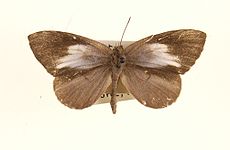- Miletus symethus
-
Great Brownie 
Female.Museum specimen from Malaya Scientific classification Kingdom: Animalia Phylum: Arthropoda Class: Insecta Order: Lepidoptera Family: Lycaenidae Genus: Miletus Species: M. symethus Binomial name Miletus symethus
(Cramer, 1779)Synonyms Gerydus symethus
The Great Brownie (Miletus symethus)[1][2] is a small butterfly found in India[3][4] that belongs to the Lycaenids or Blues family.
Contents
Range
It is found in Naga hills in India , Myanmar[3][4] Malaya, Sumatra and the Philippines.
Status
Description
A small butterfly, 40 to 50mm in wingspan, the largest of the genus. The upper forewing in both sexes has a broad white discal band which extends right up to dorsum, the upper edge of which is sharply angled at vein 3. The upper hindwing has a pale discal streak.[4]
Technical description
- See glossary for terms used
The male has the upperside of wings dusky brownish-black. The groundcolour of the forewings darker, almost pure black in fresh specimens, on the apical third of the wing; a short streak in the middle of interspace 1, a more outwardly produced similar streak in interspace 2, basal halves of interspaces 3 and 4, the lower apex of the discoidal cell and the extreme base of interspace 5, white, all forming a median conspicuous irregular white patch on the wing, narrowly traversed by the veins which are greyish-brown. Hind wing: more uniform, slightly darker on its anterior half. Underside: light brown with an ochraceous tint. Fore wing: the median white patch as on the upperside but larger, its margins less clearly defined, continued posteriorly to the dorsal margin; obscure catenulated, incomplete, transverse, white-margined narrow bands, two at base and two or three very short ones above the white median patch on the costal area, from between the outer two of these latter a transverse, zigzag, very slender, somewhat obscure white line crosses the anterior portion of the wing to vein 4; lastly a pre-tornal quadrate brown spot near apex of interspace 1a and an obscure sub-terminal transverse series of slightly lunular small brown spots; the ground-colour terminally paler and more ochraceous than on the inner portions of the wing. Hind wing: crossed by very obscure sinuous brown and white slender lines, that on the costal area form very short, obsolescent, catenulated narrow brown bands; a subterminal series of brown slender lunules, sometimes obsolete. Antennae, head, thorax and abdomen brown; beneath : paler, the palpi and thorax more or less white.
The female has the upperside forewings of a dark brown colour; base shaded with greyish brown; the white median patch as in the male, but very much larger, its upper margin irregularly curved; it is spread over the anterior two-thirds of the cell, extends beyond it into the bases of interspaces 4, 5 and 6, and below the cell it occupies the basal four-fifths of interspaces 1 and 2.Hind wing: costal margin broadly dark brownish; wing posteriorly from below the subcostal vein and vein 6a beautiful pale bluish-grey; a broad whitish streak beyond the cell not reaching the termen. Underside, fore wing: the median white patch as on the upperside but larger, extending to the dorsal margin and base of cell; base of wing, costal margin above the sub-costal vein and conjoined upper discal obliquely-placed patch greyish brown; apex of wing whitish, termen between veins 1 and 6 broadly stained with rusty; a conspicuous rusty pretornal spot; some obscure white-margined spots at base of cell and along costa, and a transverse sub-terminal series of black dots. Hind wing: pale ochraceous white, darkening to rusty brown towards the middle of the termen; a subbasal, a median and a discal transverse incomplete macular brown band, each spot in the bands margined on the inner and outer sides by slender black lines; finally a subterminal transverse series of short slender black threads. Antenna, head, thorax and abdomen as in the male.[5]
Taxonomy
The butterfly was earlier known as Gerydus symethus' (Cramer).[4]
Cited references
- ^ Page on Marrku Savela's site for genus Miletus (Lycaenidae).
- ^ Card for species biggsii in LepIndex. Accessed 05 December 2006.
- ^ a b c Evans, W.H.(1932) The Identification of Indian Butterflies, ser no H5.6, pg 211.
- ^ a b c d e Wynter-Blyth, M.A. (1957) Butterflies of the Indian Region, pg 254.
- ^ Bingham, C. T. 1907. Fauna of British India. Butterflies. Volume 2
See also
References
Print
- Bingham, C. T. (1907) Fauna of British India including Ceylon and Burmah - Butterflies. Vol. II. , (ed. 1)
- Evans, W.H. (1932) The Identification of Indian Butterflies. 2nd Ed, (i to x, pp454, 9 figs, Plates I to XXXII), Bombay Natural History Society, Mumbai, India.
- Wynter-Blyth, M.A. (1957) Butterflies of the Indian Region, Bombay Natural History Society, Mumbai, India.
Online
- Beccaloni, G. W., Scoble, M. J., Robinson, G. S. & Pitkin, B. (Editors). 2003. The Global Lepidoptera Names Index (LepIndex). World Wide Web electronic publication. [1] (accessed 26 September 2007).
- Savela, Marrku Website on Lepidoptera [2] (accessed 26 September 2007)
External links
- Asahi Correctly determined photos of Miletus symethus
Categories:- Miletus (genus)
- Miletinae
- Butterflies of India
Wikimedia Foundation. 2010.

